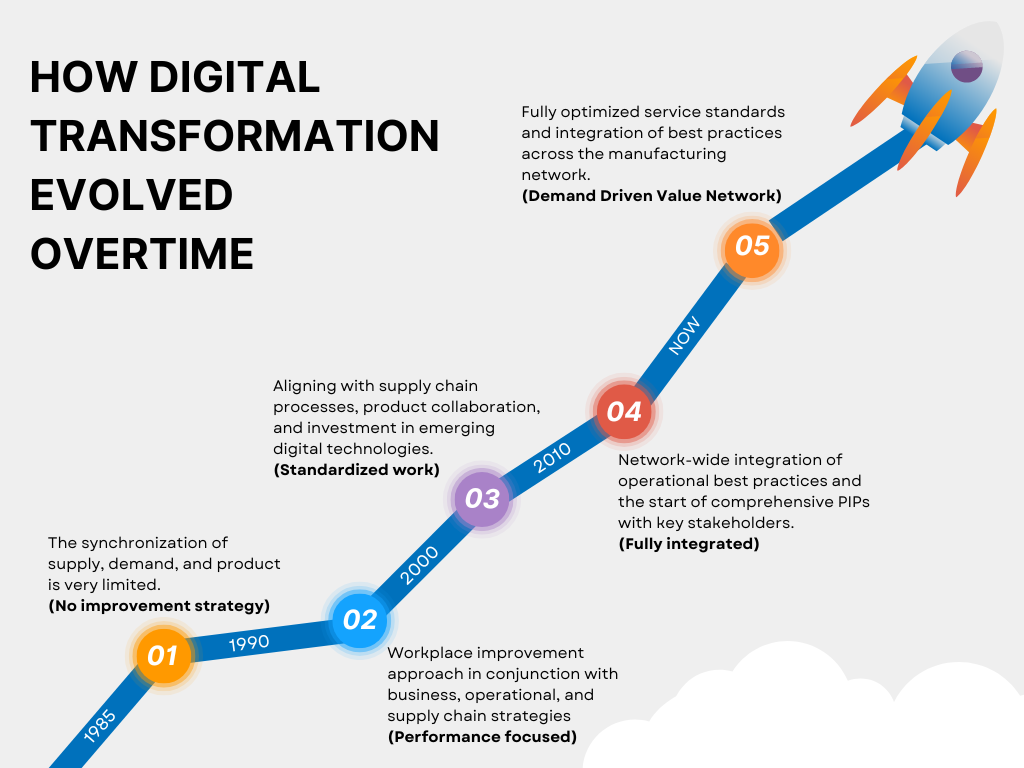The digital revolution gave birth to the Internet era. Until the internet, communication between computers was done via leased lines. The emergence of digital transformation began as the internet gained popularity in society.
What is Digital Transformation?
It can be challenging to come up with a definition that applies to every organization because digital transformation will appear different for every one of them. However, in general, we refer to digital transformation as the integration of digital technology into every aspect of a business, which profoundly impacts how those firms run and how they provide value to customers. Beyond that, it's a cultural shift that necessitates constant status quo challenge, frequent experimentation, and comfort with failure on the part of organizations. This can often entail abandoning established business procedures upon which businesses were founded in favor of more recent procedures currently being developed.
Why is digital transformation crucial?
As the world moves towards more digital. It is important to know how businesses can stay competitive and relevant. Many business leaders don't understand what "digital transformation" means. Is it just a way to say "moving to the cloud"? What exact steps do we need to take? What do we need to do? Or hire a consulting service to help us plan for digital transformation? What needs to change about our business plan? Does it worth it?

Everything changes when the organization goes digital:
Your corporate strategy is modified.
It modifies the way your company operates.
It alters the business capacity for marketing.
Digital transformation isn’t just about technology. It’s also about aligning your teams and processes to foster innovation.

It's also important to remember that different companies are at various points on the path to digital transformation. Many businesses feel stuck in their work on digital transformation. One of the most challenging questions is how to get over the first bumps from vision to execution. It causes stress because many organizations think they are far behind their peers regarding transformation, which isn't true.
After the COVID-19 pandemic, businesses across many industries and geographical areas have changed their business practices for years. Businesses have sped up by three to four years the digitization of their internal operations and relationships with their customers and supply chains. But doing that IT leaders still have to deal with problems like budgeting, finding the right people, and changing the culture.
Evolution of Digital Transformation:
The necessity of competitive market conditions has long been the inspiration for enterprise organizations whether it is large or small—in essentially every industry striving to prioritize digital transformation. Recent years have seen a bit of a rush caused by the need for cloud-based digital transformation, with new tools and technologies becoming available every week that make work more efficient.
Here is a breakdown of the way the digitization of the corporate world has evolved and what is going to be important of moving forward:

Acceleration of Digital Transformation:
Businesses that were able to speed up their digital transformation often had a competitive advantage in the early years of digitalization. It signified that their procedures became more user-friendly and cost-effective than their rivals. Companies that still needed to embrace the new norms needed to catch up. They faced the danger of further game alterations while their digitally advanced rivals were circumventing obstacles by accelerating.
Consumer behavior is one of many aspects of business that is now changing quickly. The epidemic has sparked the entire situation, and corporate executives from various sectors have realized how critical it is to accelerate their digital transformation. According to a Cisco survey Over 70% of small businesses are speeding up their digital changes.
The fundamental reason digital transformation must be accelerated is that to thrive in today's harsh economy, a company must move quickly and adapt to changes, or else it will struggle to remain relevant. Competitors will seize the lead in the market. Businesses that can expedite digital services may find that they can achieve growth in a short time.

There are 3 key areas of successful digitalization
Modernization - The first and simplest step of digital evolution is modernization. It means transforming a non-digital product or service into a digital one
Digitalization - The digitization stage is the next. Because businesses now begin utilizing digital tools to handle entire processes, this is one of the most crucial stages of digital adoption.
Digital Transformation - When digital technologies support strategic decisions, it is referred to as an innovative and disruptive company transformation.
Companies can use customer-centric design thinking at this point to glean customer insights and then increase consumer engagement. They focused on reinventing the overall business strategy to develop a competitive advantage and sustain high growth.
Businesses and consumers continue to benefit from new opportunities through digitization. Every stage has obstacles, particularly when determining the right action plan. Not just specific companies but entire industries experience dramatic change. Successful innovators are adaptable and open to transformation, optimization, and digitization.
Because of digital transformation, the New Gold of the Digital Age is data.
We all agree that one of the most valuable resources for humanity is oil. Still, a new oil has developed in the fourth industrial revolution age, which includes innovation, technology, and artificial intelligence. Data is the new crude of the digital age.
Data will have considerably greater value when processed, analyzed, and used quickly and effectively for digital transformation, similar to how oil increases in value when converted into more valuable products.
Learn how data changed the course of digital transformation and how it made the tech industry move toward cloud adoption in the next blog.
